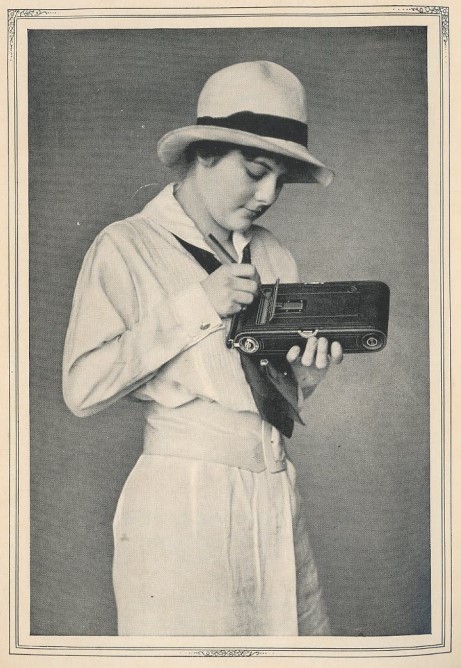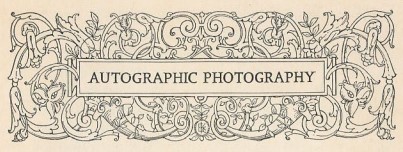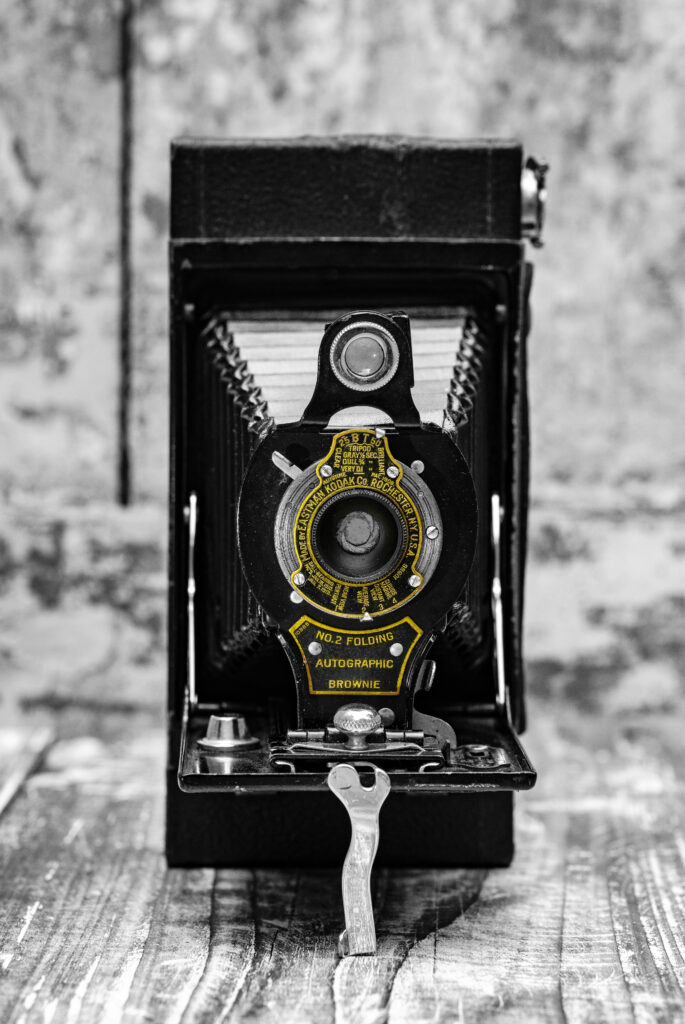Kodak’s promotional text below comes from From Kodak and Kodak Supplies, 1915 and describes the benefits of autographic photography. It strikes me that the slogan You write the title; it does the rest is overstated, as the autographic system consists only of writing on the negative! It’s probably also somewhat optimistic to state that every negative that is worth making, is worth dating and titling, as it is somewhat contrary to the concept of the snapshot. I did, however, enjoy Kodak’s reference to a jocose caption as part of this assertion. It is not a phrase you see every day.

In practice, the photographer opened a small light tight hatch on the back of the autographic camera and entered their desired text using a dedicated metal stylus or pencil. This brief exposure, and the use of special film, enabled the inscription to appear on the the negative.
The Autographic Film Cartridge consisted of a spool of ordinary N. C. (Non Curl) film with a backing paper which was not quite light-proof. Between the backing paper and the film was a strip of carbon-like paper. The two together formed a light-proof barrier to the film.
Once the hatch in the back of the camera was opened the backing paper was expose, and by writing on the backing paper with the dedicated stylus (or pencil) the carbon layer was disturbed and made no longer light-proof.
The door needed to be held open for a few seconds to expose the writing- which then appeared in the negative. Kodak specified opening the door to the sky but not directly to the sun.
The system was common on Kodak cameras from 1915 but did not prove popular despite being heavily promoted by Eastman (as the Ad and text below shows!). It was discontinued in 1932. Here is the promotional text – the italics are mine.
“And now comes Autographic Photography to add still further charm and practical utility to the Kodak system of picture making.
What is Autographic Photography?
What this new Autographic feature means to the amateur, can best be appreciated by looking over some old negatives. How many of these positively can be identified? Who was this? When was this taken? Where was that taken? The Autographic feature eliminates all this confusion, the idea being, not only to make such record at the time the exposure is made, but to make it as permanent a part of the negative as the picture itself. You write the title; it does the rest.

To go on a trip and come back with the full assurance that you know when and where each picture was made — that is the motive in Autographic Photography. The traveller, the motorist or the vacationist often finds it difficult to identify certain pictures that may have been made some time previously. An Autographic Kodak enables one to date and title easily and almost instantly each exposure as it is made.
The parent needs the dates and interesting facts to make the picture story of the child, from babyhood, complete; the architect, the engineer or the contractor, who makes progressive pictures showing the condition of work accomplished; the careful amateur, who wishes to improve his work by keeping a memorandum of exposures; the farmer or stock grower, who is buying or selling stock – to all of these the Autographic Kodak fulfils most forcefully, the purpose for which it was de-signed, and offers a means of positive identification or record of each exposure, not hitherto possible in any photographic process.
Every negative that is worth making, is worth dating and titling, if for no other reason than for future identification. It may be the signature of a friend you have photographed; the name of an acquaintance; the record of work completed; the brief description of some place of historic interest, or in lighter vein, a mere jocose caption, or it may be information that will lead to better photographic results.
The value of the Autographic feature lies in the fact that the date and title are kept as a permanent record on the negative. It is not a part of the plan that the writing shall appear on the print itself, but it is obvious that it can easily be included on the print, if desired.
How it is done.
The Autographic Kodak has a spring door in the back which is closed by a stop. This little door covers the slot through which the writing is done on the red paper protecting the film. Any medium hard pencil, or the stylus which is provided for the purpose, can be used for writing the titles. The slot is so located as to bring the title into the margin between the exposures, when the number appears centered in the little red window. This brings the title at the bottom of an upright, or at the left end of a horizontal negative.
The Autographic Film Cartridge differs from the regular N. C. Film Cartridge in this respect: A thin red paper is used, instead of the familiar red and black (duplex) paper. This red paper, in itself, is not fully light-proof, but between it and the film is a thin strip of black displacing tissue which serves the double purpose of light proofing the cartridge, and of permitting the recording on the film, by light, of the writing upon the red paper. When the data has been written on the red paper, and printed (by exposing with door open to the sky, but not the sun, for from one to five seconds) the record is photographically impressed on the film, and appears when the film strip is developed.
The process of development of the Autographic Film Cartridge is exactly the same as with the Kodak N. C. Film Cartridge. Autographic Kodaks may be used with the regular Kodak N. C. Film Cartridges. The other models of Kodaks may be used with Autographic Cartridges, but to get Autographic results, you must use an Autographic Kodak and Autographic Film.

All Kodaks, with the single exception of the Panorams, are now Autographic.”
EASTMAN KODAK CO.
ROCHESTER, NEW YORK
“The Kodak City”
